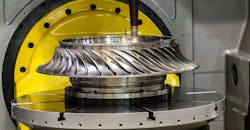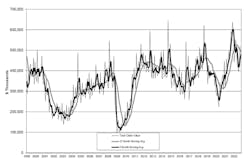Machine Tool Orders Dropping as 2022 Ends
U.S. machining operations ordered $457.7 million worth of new machine tools during October, a drop of -11.6% from September and -19.7% lower than the October 2021 result, according to the latest U.S. Manufacturing Technology Orders Report published by AMT – the Association For Manufacturing Technology.
Through ten months of ordering activity, January through October, U.S. machine tool orders totaled $4.67 billion, on par (+0.1%) with the comparable 2021 total.
The USMTO report summarizes monthly totals of nationwide and regional demand for metal-cutting and metal-forming and -fabricating machinery. It is a forward-looking indicator of overall manufacturing activity, as machine shops and other manufacturers make capital investments in preparation for demand expected in the weeks and months ahead.
“Although we are reporting a down month and near-flat year-to-date sales, orders for manufacturing technology continue to come in at a near-record pace,” stated AMT president Douglas K. Woods, president of AMT. “October 2022 was the third-highest October on record. Typically, orders in an October after an IMTS are down 23% from the previous month. Orders are returning to normal seasonal trends, but at an elevated level.”
AMT noted that all of the industrial sectors that contribute to the demand that drives new orders have resumed independent trends, in contrast with the past two years when all segments were either reducing orders (2020) or increasing orders (2021) at the same time. “For example, job shops are placing fewer orders for machinery as they return to their core customers such as aerospace and automotive,” the group stated.
October orders rose from construction machinery builders (apparently in expectation of rising demand due to federally sponsored infrastructure programs) while HVAC and appliance manufacturers decreased orders (presumably a result of new home construction projects decreasing as interest rates rise.)“While machinery orders from job shops are slowing, that trend could reverse if the economy tumbles into a mild recession,” according to Woods. “In uncertain economic times, manufacturers tend to contract out any excess capacity needs instead of investing in additional machinery. This, in turn, leads job shops to require additional capacity of their own.”
In the regional summaries, USMTO showed only modest monthly increases in October order values in the South Central (+4.9%) and West (+0.8%); while the order value decreases ranged from -9.1% in the Northeast to -22.3% in the North Central-West.
The annual results were poor across all regions, with the best result being a -3.7% year-over-year order value in the South Central, down to the North Central-West’s -29.0% decrease versus October 2021.
In the regional year-to-date results, the best new-order values were recorded for the South Central region (+13.6%), and the poorest total was posted by the North Central-West region, -10.4%.
“While it will be difficult to match the amazing end to 2021, we are optimistic the orders through the remainder of 2022 will result in only a modest decrease from our best year on record,” according to Woods.
“The bonus depreciation passed in the 2017 Tax Cuts and Jobs Act will begin to sunset in 2023, likely accelerating orders that would have otherwise been placed in the following year. The impact of these additional orders may be offset by rising interest rates and slowing delivery times,” he concluded. “Even anticipating a modest decline, it seems there is still steam behind this historic run of investment in manufacturing technology.”

